-
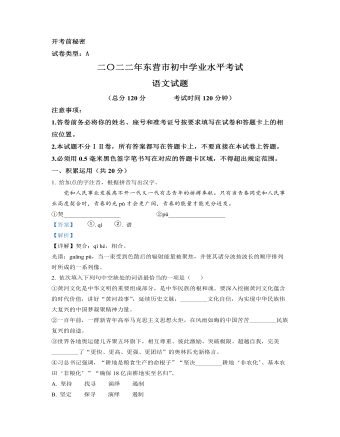
2022年山东省东营市中考语文真题(解析版)
夫所为求福而辞祸者,以福可喜而祸可悲也。人之所欲无穷,而物之可以足吾欲者有尽,美恶之辨战乎中,而去取之择交乎前。则可乐者常少,而可悲者常多。是谓求祸而辞福。夫求祸而辞福,岂人之情也哉?……是以美恶横生,而忧乐出焉,可不大哀乎!
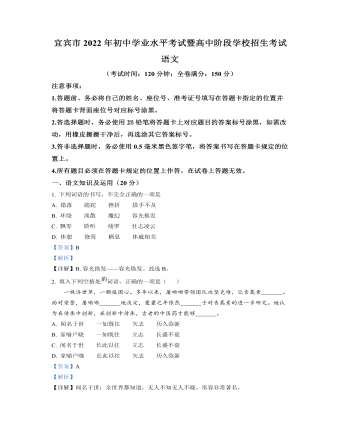
2022年四川省宜宾市中考语文真题(解析版)
①我要笑遍世界。②只有人类才会笑。树木受伤时会流“血”,禽兽会因痛苦和饥饿而哭嚎哀鸣。然而,只有我才具备笑的天赋,可以随时开怀大笑。从今往后,我要培养笑的习惯。③笑有助于消化,笑能减轻压力,笑是长寿的秘方。现在我终于掌握了它。④我要笑遍世界。

2022年四川省自贡市中考语文真题(解析版)
国际奥委会宣布这一决定后一年,便是2016年的里约奥运会。在2016年8月下旬举办的里约奥运会闭幕式上,奥运历史上第一个“追思时刻”出现了。这个环节被放在文艺表演开始之初,由男声朗诵巴西传统的葡萄牙语诗歌《思念》,体育场内的投影则随着朗读声的韵律演绎着代表“思念”的葡萄牙语文字。从2016年里约奥运会开始,闭幕式的“追思时刻”环节就被固定了下来。2018年的平昌冬奥会选择用类似葬礼的形式展示,2021年举办的东京奥运会则展现了日本的“物哀文化”。
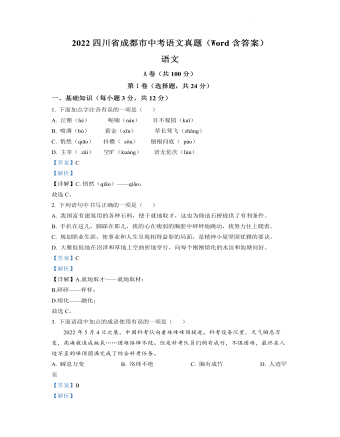
2022年四川省成都市中考语文真题(解析版)
中华民族的传统节日很多,除了端午节,还有元宵节、花朝节、上巳节、清明节、重阳节——这些传统节日的习俗也很丰富。元宵节吃汤圆,猜灯谜,赏花灯。清明节祭先祖,放风筝,荡秋千。二月十二花朝节,民间有“贯红”之俗,文人雅士会相聚饮酒,赋诗唱和。三月三上巳节,人们以香草沐浴,与亲友携游……丰富的习俗让传统节日成为古往今来人们共同的期盼。
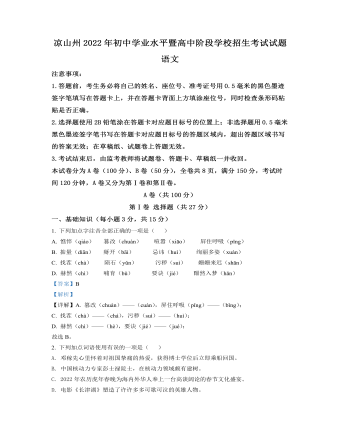
2022年四川省凉山州中考语文真题(解析版)
5000多年源远流长的文明历史中,中华民族始终有着“自古英雄出少年”的传统,始终有着“长江后浪推前浪”的情怀。一百年前,共青团成立之际,一大批先进青年在“觉醒年代”纷纷觉醒。新时代建设中,哪里有需要,哪里就有青年的身影:在抢险救灾前线冲锋陷阵,在疫情防控一线披甲出征,在平凡的岗位上兢兢业业,在美丽的校园里不懈奋斗……“清澈的爱,只为中国”,成为当代中国青年发自内心的最强音。
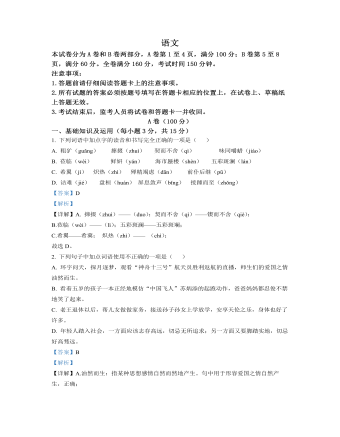
2022年四川省内江市中考语文真题(解析版)
见渔人,乃大惊,问所从来。具答之。便要还家,设酒杀鸡作食。村中闻有此人,咸来问讯。自云先世避秦时乱,率妻子邑人来此绝境,不复出焉,遂与外人间隔。问今是何世,乃不知有汉,无论魏晋。此人一一为具言所闻,皆叹惋。余人各复延至其家,皆出酒食。停数日,辞去。此中人语云:“不足为外人道也。”
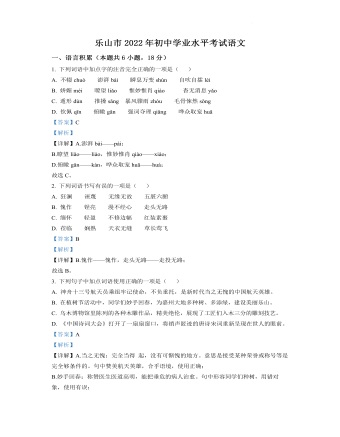
2022年四川省乐山市中考语文真题(解析版)
阅读下面这首宋诗,完成下面小题。插秧歌杨万里田夫抛秧田妇接,小儿拔秧大儿插。笠是兜鍪①蓑是甲,雨从头上湿到胛②。唤渠③朝餐歇半霎,低头折腰只不答:“秧根未牢莳未匝④,照管鹅儿与雏鸭。”【注】①兜鉴:古代战士戴的头盔。②胛:肩胛。③渠:他。④莳未匝:插秧没有完成。
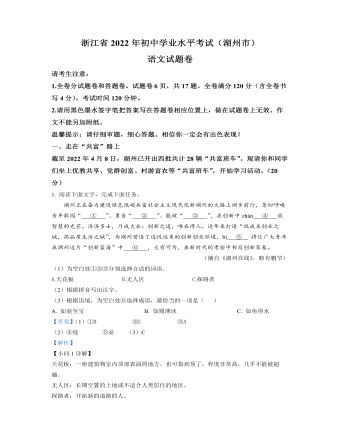
2022年浙江省湖州市中考语文真题(解析版)
地瓜没进过城,没见过世面,没受过励志教育。除了憨,它没别的见识和想法。被我那也没见过世面的爹爹埋没在土里。埋没了就埋没了。土里暖和,土里有营养。果然,这没见过世面的傻子,却长成了敦实汉子,地道的瓜。一排排黄瓜手扶着藤蔓做引体向上体操。
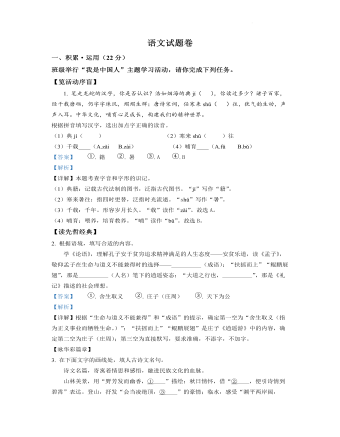
2022年浙江省杭州市中考语文真题(解析版)
“我会帮您拿包裹,给您买咖啡,帮您跑邮局……每一分钟,您都会看到我从这里进进出出。感受一下这双鞋子,桑德森先生,想象它会带着我跑得多么快。感觉到里面的弹簧了吗?感觉到鞋子内部在奔跑了吗?感觉到我能够飞快地干完这些事情不让您操一点心了吗?您悠闲地待在凉爽的店里,而我在满城跑!不过,到处跑的可不是我,而是鞋子。它什么地方都可以去!”
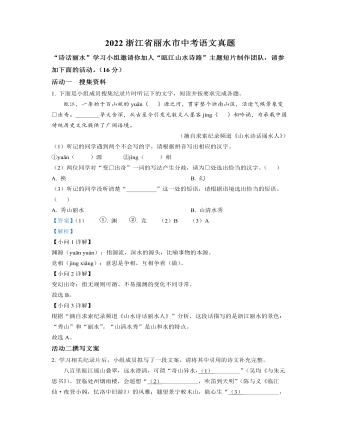
2022年浙江省丽水市中考语文真题(解析版)
莫言,原名管谟业,1955年生于山东高密,著名作家,2012年获得诺贝尔文学奖。据高密管氏族谱记载,高密管氏是从龙泉迁过去的。2010年,莫言到龙泉寻根问祖时表示,自己是高密管氏的第二十四代子孙、龙泉管氏的第三十六代子孙,祖上是北宋名臣、龙泉人管师仁。莫言曾题诗表达对龙泉之行的感想:“龙泉祖居地,山水呈瑞祥。诗成白云岩,根系石马岗。宝剑生紫气、青瓷吐幽光。惭愧我来晚,千里献心香。”
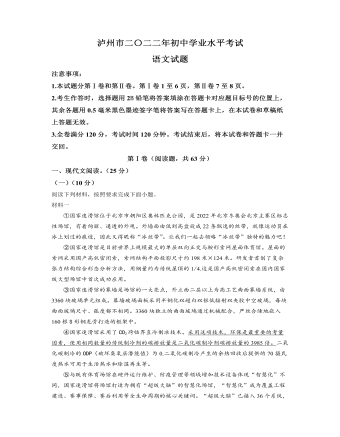
2022年四川省泸州市中考语文真题(解析版)
大雪纷飞的日子,教室内暖气充足,温暖如春。大地负责的那盆对对红,,早已长出一片片流油般的绿叶。叶片都是两侧对生,先端渐尖,如一柄柄出鞘的青剑,亦如大地那一对好看的剑眉。两叶中间也长出了高接不一肥粗直溜的茎。离考试还有三周的时候,大地于某个课间拾绿叶擦拭灰尘时,发现那些茎顶端竟都一左一右鼓出了大花苞。大地的身体里瞬间灌入一股热流,心里充满期待。
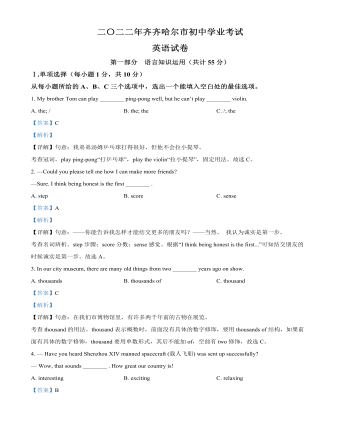
2022年黑龙江省齐齐哈尔市中考英语真题(解析版)
B: For 3 days. I expect togo there again.A: Lucky you. I had to stayat home. But I’m planning to travel to Mount Changbai.B: Oh, that’s a good place.I went there three years ago.
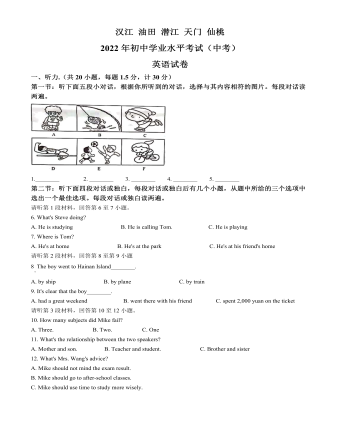
2022年湖北省江汉油田、潜江、天门、仙桃中考英语真题(解析版)
Penny’s family was very poor. Her father was asailor (水手).He earned very little money and was ____16____ away from home. Her mothercould not work ____17____she was often sick. One day.
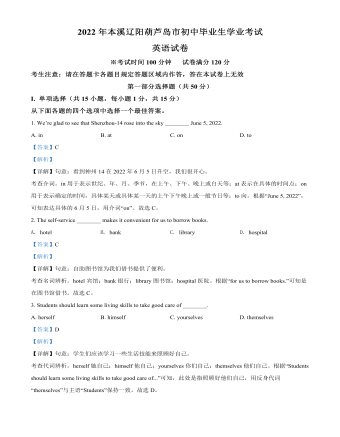
2022年辽宁省本溪市、辽阳市、葫芦岛市中考英语真题(解析版)
A bird went to look for happiness. On ___21___ way, she saw a flower, the flower was short ofwater, but his face was full of ___22___ .
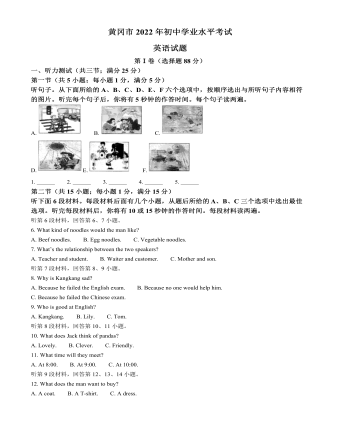
2022年湖北省黄冈市、孝感市、咸宁市中考英语真题(解析版)
When he was 12, his parents died. He was aloneand didn’t ____11____others. No one showed kindness to him. People always laughed ____12____ him. His only friend was adog named Bobby. He ____13____his dog enough to eat and drink, but he was a little rude(粗鲁的)to it sometimes.
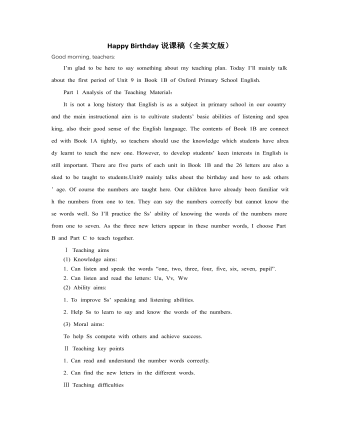
人教版新课标PEP小学英语三年级上册Happy Birthday(全英文版)说课稿
1. Do some exercise on the paper. There are four kinds of exercise here. The exercise 1 is to develop Ss’ ability of listening. Exercise 2 is to practice Ss’ ability of knowing the words. Exercise 3 is to develop Ss’ ability of speaking numbers and letters. Exercise 4 is to make Ss know the words and letters well. These exercises can consolidate the new knowledge from different styles of problems.2. Then tell Ss that we can sing the numbers like “ Do, re, mi, fa, so, la, ti, do” and let them listen to a song named “Do, Re, Mi”. Add some extra knowledge so that Ss will be glad to see that the numbers can be used in another way.Step 4 Homework1.Read the numbers from 1 to 7 and 7 to 1 five times.2.Read the letters “u, v, w” five times follow the tape.Reading is a useful way for the Ss of Grade One to practice the knowledge. Ask Ss to imitate reading from the tape in order to make Ss have a good habit of listening and let them have a better pronunciation.Step 5 Board writingI ‘ll put the seven numbers like a scale(音阶)as I’ll let Ss know that we can sing out the numbers. When it comes to listen to the song, I ‘ll draw a musical note on Bb. Unit 9 Happy birthday!sevensixfivefourthree U u V v W wtwo pupil five windowoneThat’s all for my class designing. Thank you for listening!
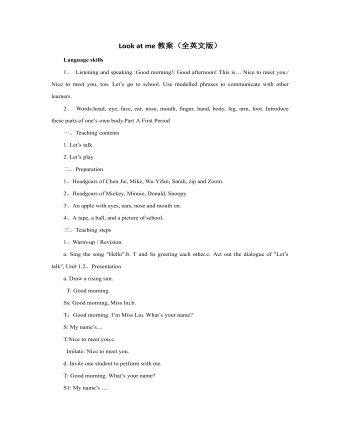
人教版新课标PEP小学英语三年级上册Look at me教案(全英文版)
3、Practicea. Nice to meet you. Nice to meet you,too.b. Perform the dialogue.c. Arrange the dialogue according to the pictures or sentence cards.d. Let’s play.A: Good afternoon,B. This is C. Hello, C! Nice to meet you.C: Nice to meet you, too.A,B: Goodbye!C: Bye!4、Assessment Workbook page 10Add-activitiesa. Listen to the recording and repeat.b. Make a dialogue according to "Let’s talk".Second Period一、Teaching contents1. Let’s learn Words:body, leg, arm, hand, finger, foot.1. Let’s do二、Preparation1、a puppet2、Cards of body, leg, arm, hand, finger and foot.3、headgear of a captain三、Teaching steps1、Warm-up/ Revisiona. Captain says to review "let’s do" of Part A.b. Perform the students their own dialogues.2、Presentationa. Learn to say "body, leg, arm, hand, finger and foot."b. Listen to the recording and repeat.c. Let’s do. Clap your hands. Snap your fingers. Wave your arms. Cross your legs. Shake your body. Stamp your foot.3、Practicea. Let’s draw a person.b. Let’s do. Point out which picture.c. Let’s do. Who responses faster.4、Assessment Workbook page 115、Add-activitiesa. Listen to the recording, repeat and act out.b. Say all the names of the body to your parents.Third Period一、Teaching contents1. Let’s check2. Let’s chant二、Preparation1、stationeries1、pictures of parts of Zoom
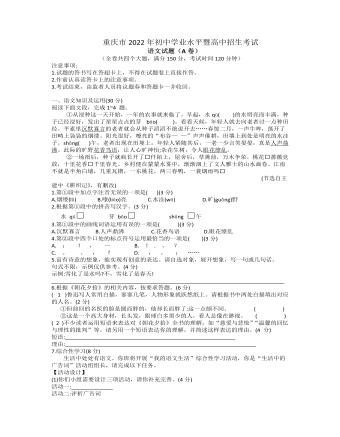
2022年重庆市中考语文A卷
这一天,阳光明亮,大鸟忽然觉得它的双脚可以抬起了。它十分激动地对冰山说:“我能飞了,我能飞了,我可以回家啦!”它扇动翅膀,飞了起来。可是,大鸟很快掉进了海水里。它好几天没吃东西,已经没有一丝力气。
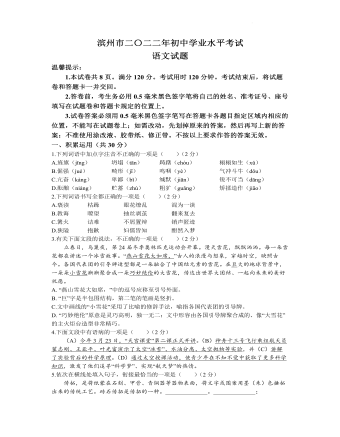
2022年山东省滨州市中考语文真题
【甲】大道之行也,天下为公。选贤与能,讲信修睦。故人不独亲其亲,不独子其子,使老有所终,壮有所用,幼有所长,矜、寡、孤、独、废疾者皆有所养,男有分,女有归。货恶其弃于地也,不必藏于己;力恶其不出于身也,不必为己。是故谋闭而不兴,盗窃乱贼而不作,故外户而不闭。是谓大同。
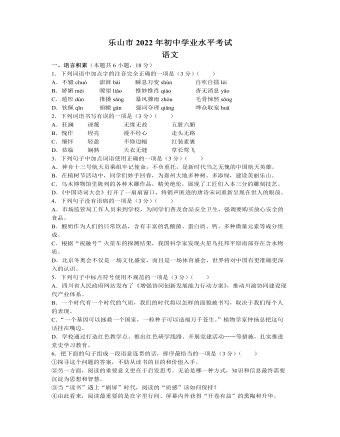
2022年四川省乐山市中考语文真题
中华民族拥有5000多年灿烂文明。弘扬中华美育精神,用美育涵养“美丽心灵”,不妨从教育引导年轻人热爱艺术开始。年轻人通过认识和理解中华大地上的优秀艺术作品,可以形成开阔的视野和包容的心态,增强文化自觉和文化自信。引导年轻人接近、欣赏中国文艺作品之美,有助于赓续优秀文化传统,增强做中国人的志气、骨气、底气。





















